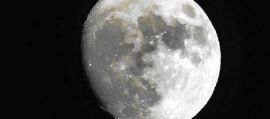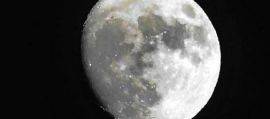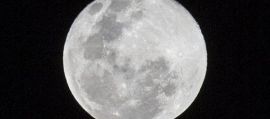Il razzo Artemis 1 effettua uno storico lancio sulla luna
Il razzo più potente mai costruito dalla NASA è volato nello spazio in un viaggio verso la Luna e ritorno
| Richard Brewer |

Immagine: il razzo lunare senza equipaggio Artemis 1 si solleva
USA — Mercoledì 16 novembre 2022, 0647 GMT (01:47 EST) lo Space Launch System (SLS) è decollato in un tripudio di luci e suoni dal Kennedy Space Center in Florida per un viaggio verso la Luna che segna l'inizio di Il nuovo programma Artemis della NASA e inaugura una nuova era di esplorazione.
L'ultima volta abbiamo inviato astronauti sulla Luna durante l'era Apollo dal 1969 al 1972 e questa volta l'obiettivo sarà quello di costruire una presenza sostenuta per aiutare a prepararsi per un'eventuale missione su Marte. "Stiamo tornando sulla Luna, non solo per il gusto di andare sulla Luna, ma per imparare a vivere sulla Luna per prepararci a inviare gli umani fino a Marte", ha detto l'amministratore della NASA Bill Nelson dopo il lancio.
Poiché non ha mai volato prima, la missione principale di Artemis I è testare il sistema di lancio spaziale e la navicella Orion prima di imbarcare gli astronauti per la missione Artemis II. Producendo una spinta record di 8,8 milioni di libbre da due booster e quattro motori sul razzo più potente mai costruito, l'astronave Orion senza equipaggio è stata inviata sulla Luna.
L'ambizioso programma Artemis si basa sull'eredità dell'Apollo e introdurrà l'era moderna dell'esplorazione e dello sviluppo umano nello spazio profondo. Nei 50 anni trascorsi dall'ultima volta che gli umani hanno visitato la luna, nuove domande e obiettivi di esplorazione umana dello spazio stanno guidando la ricerca per riportare gli umani sulla luna. Il programma iniziale di Artemis si compone di tre parti... Artemis testerò il sistema di lancio e il veicolo spaziale. Artemis II è la prima missione oltre l'orbita terrestre bassa con un equipaggio umano in 50 anni ed eseguirà un sorvolo lunare. Artemis III sarà il primo sbarco sulla Luna con equipaggio dall'Apollo 17 nel 1972.
Artemide nell'antica mitologia greca era la sorella gemella di Apollo e dea della Luna. La sua indipendenza e la sua forza hanno ispirato a lungo le donne e quindi è giusto che la NASA, attraverso questo nome di programma, riconosca le donne nella scienza e pianifichi di estendere l'eredità di Apollo di far atterrare i primi uomini sulla superficie della Luna facendo atterrare la prima donna su Artemis III la luna. La prima donna metterà piede sul polo meridionale della Luna, un luogo che nessun essere umano ha mai raggiunto prima.
Passeggeri intenzionali: sebbene la capsula spaziale Artemis I Orion non trasporti esseri umani in questo primo volo di prova, ha a bordo tre manichini dotati di sensori per raccogliere dati sulla sicurezza per i futuri membri dell'equipaggio. Occupando il posto del comandante, un manichino completo è stato ufficialmente chiamato "Comandante Moonikin Campos" in onore di Arturo Campos, un giocatore chiave nel riportare in salvo sulla Terra un'astronave dell'Apollo 13 paralizzata nel 1970. Le forze di accelerazione e vibrazione sperimentate durante l'ascesa e il rientro essere misurato dai sensori sul manichino e i dati saranno utilizzati per valutare gli effetti sui soggetti umani prima di Artemis II.
Occupando i due posti inferiori ci sono altri due "passeggeri" di Orione su Artemis I per testare i livelli di radiazione per le missioni nello spazio profondo. Si tratta di due torsi fabbricati con materiali che imitano ossa umane, tessuti molli e organi di femmine adulte. I loro nomi sono "Helga" e "Zohar". Zohar indosserà un giubbotto antiradiazioni mentre Helga no. Con due torsi identici gli scienziati saranno in grado di determinare quanto bene i giubbotti potrebbero proteggere l'equipaggio dalle radiazioni solari e misurare la quantità di radiazioni che gli astronauti possono sperimentare all'interno di Orion in una missione lunare - condizioni che non possono essere ricreate sulla Terra. Le forme femminili sono state scelte perché le donne in genere hanno una maggiore sensibilità agli effetti delle radiazioni spaziali, ma il giubbotto è progettato per proteggere sia uomini che donne.
Oltre la Luna: la navicella spaziale Artemis I Orion dovrebbe raggiungere la luna entro lunedì, a più di 370.149 chilometri (230.000 miglia) dalla Terra, e dopo aver effettuato il suo avvicinamento lunare più vicino, entro 129 chilometri (80 miglia) dalla superficie, si sposterà a quella che viene chiamata Distant Retrograde Orbit (DRO), un'orbita distante della luna che si avventura a 64.000 chilometri (40.000 miglia) oltre il lato opposto, più lontano di qualsiasi altro veicolo spaziale abitabile finora. Tale orbita fornisce un lungo viaggio in un ambiente dello spazio profondo per sottoporre a stress test i sistemi di Orion.
Al ritorno sulla Terra, accelererà a una velocità di circa 40.000 km/h (25.000 mph) che produrrà una temperatura di circa 5.000 gradi C (9032 gradi F) durante l'ingresso nell'atmosfera, fornendo un test dello scudo termico e del paracadute di Orione. La missione durerà circa 26 giorni con ammaraggio nell'Oceano Pacifico l'11 dicembre.
Questo lancio inaugurale di Artemis I ispirerà le generazioni a venire. La Luna è indicata come la pietra angolare del sistema solare e detiene un vasto potenziale scientifico. Il programma Artemis porterà gli esseri umani sulla Luna e su Marte e ritorno. "Questo è il prossimo inizio, questa è la generazione Artemis", ha detto l'amministratore della NASA Bill Nelson mentre assisteva al lancio.
************** IN ENGLISH **************
Image: Artemis 1 unmanned moon rocket lifts off
USA — Wednesday, 16 November 2022, 0647 GMT (01:47 a.m. EST) the Space Launch System (SLS) lifted off in a blaze of light and sound from the Kennedy Space Center in Florida on a journey to the Moon marking the beginning of NASA’s new Artemis program and ushering in a new era of exploration.
We last sent astronauts to the Moon during the Apollo era from 1969-1972 and this time the aim will be to build a sustained presence to help prepare for an eventual mission to Mars. “We are going back to the Moon, not just for the sake of going to the Moon, but to learn how to live on the Moon in order to prepare to send humans all the way to Mars,” NASA administrator Bill Nelson said after the launch.
Since it has never flown before, the primary mission of Artemis I is to test the Space Launch System and the Orion spacecraft before putting astronauts aboard for the Artemis II mission. Producing a record 8.8 million pounds of thrust from two boosters and four engines on the most powerful rocket ever built, the un-crewed Orion spaceship was sent on its way to the Moon.
The ambitious Artemis program builds on the Apollo legacy and will usher in the modern era of human exploration and development in deep space. In the 50 years since humans last visited the moon new questions and human space exploration goals are driving the quest to return humans to the moon. The initial Artemis program has three parts … Artemis I will test the launch system and spacecraft. Artemis II is the first mission beyond low earth orbit with a human crew in 50 years and will perform a lunar flyby. Artemis III will be the first crewed Moon landing since Apollo 17 in 1972.
Artemis in ancient greek mythology was the twin sister of Apollo and goddess of the Moon. Her independence and strength has long inspired women and so it is fitting that NASA, through this program name recognizes women in science and plans on extending Apollo’s legacy of landing the first men on the surface of the Moon by having Artemis III land the first woman on the moon. The first woman will set foot on the Moon’s southern pole, a place no human has gone before.
Purposeful Passengers: Although the Artemis I space capsule Orion isn’t carrying humans on this first test flight, it has three sensor-equipped dummies on board to gather safety data for future crew members. Occupying the commanders seat a full suited mannikin has been officially named “Commander Moonikin Campos” in honor of Arturo Campos, a key player in bringing a crippled Apollo 13 spacecraft safely back to Earth in 1970. Acceleration and vibration forces experienced during ascent and reentry will be measured by sensors on the mannikin and the data will be used to evaluate effects on human subjects prior to Artemis II.
Occupying the lower two seats are two other Orion “passengers” on Artemis I to test radiation levels for deep space missions. These are two torsos that are manufactured from materials that mimic human bones, soft tissues and organs of adult females. Their names are “Helga” and “Zohar.” Zohar will wear a radiation vest while Helga will not. With two identical torsos scientists will be able to determine how well vests might protect crew from solar radiation as well as measure how much radiation astronauts may experience inside Orion on a lunar mission — conditions that can not be recreated on Earth. Female forms were chosen because women typically have greater sensitivity to the effects of space radiation but the vest is designed to protect both men and women.
Beyond the Moon: The Artemis I space craft Orion should reach the moon by Monday, more than 370,149 kilometers (230,000 miles) from Earth, and after making its closest lunar approach, within 129 kilometers (80 miles) of the surface, it will move to what is called a Distant Retrograde Orbit (DRO), a distant orbit of the moon venturing 64,000 kilometers (40,000 miles) beyond the far side, farther than any other habitable spacecraft so far. Such an orbit provides an extended trip into a deep space environment to stress test Orion’s systems.
On return to Earth, it will accelerate to a speed of about 40,000 km/hr (25,000 mph) which will produce a temperature of about 5,000 degrees C (9032 degrees F) during atmospheric entry, providing a test of Orion’s heat shield and parachute. The mission will last about 26 days with splashdown in the Pacific Ocean on 11 December.
This inaugural launch of Artemis I will inspire generations to come. The Moon is referred to as the cornerstone of the solar system and holds vast scientific potential. The Artemis program will take humans to the moon and Mars and back. “This is the next beginning, this is the Artemis generation” said NASA Administrator Bill Nelson as he watched the launch.








